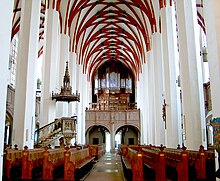Easter Oratorio
| Easter Oratorio | |
|---|---|
| BWV 249 | |
| Oratorio by J. S. Bach | |

|
|
| Original | Kommt, eilet und laufet |
| Related | based on BWV 249a |
| Occasion | Easter |
| Performed | 1 April 1725: Leipzig |
| Movements | 11 |
| Cantata text | Picander? |
| Scoring | SATB soloists and choir, instruments |
The Easter Oratorio (German: Oster-Oratorium), BWV 249, is an oratorio by Johann Sebastian Bach, beginning with Kommt, eilet und laufet ("Come, hasten and run"). Bach composed it in Leipzig and first performed it on 1 April 1725.
The first version of the work was completed as a cantata for Easter Sunday in Leipzig on 1 April 1725, then under the title Kommt, gehet und eilet. It was named "oratorio" and given the new title only in a version revised in 1735. In a later version in the 1740s the third movement was expanded from a duet to a four-part chorus. The work is based on a secular cantata, the so-called Shepherd Cantata Entfliehet, verschwindet, entweichet, ihr Sorgen, BWV 249a which is now lost, although the libretto survives. Its author is Picander who is also likely the author of the oratorio's text. The work is opened by two instrumental movements that are probably taken from a concerto of the Köthen period. It seems possible that the third movement is based on the concerto's finale.
Unlike the Christmas Oratorio, the Easter Oratorio has no narrator but has four characters assigned to the four voice parts: Simon Peter (tenor) and John the Apostle (bass), appearing in the first duet hurrying to Jesus' grave and finding it empty, meeting there Mary Magdalene (alto) and "the other Mary", Mary Jacobe (soprano). The choir was present only in the final movement until a later performance in the 1740s when the opening duet was set partly for four voices. The music is festively scored for three trumpets, timpani, two oboes, oboe d'amore, bassoon, two recorders, transverse flute, two violins, viola and continuo.
...
Wikipedia
